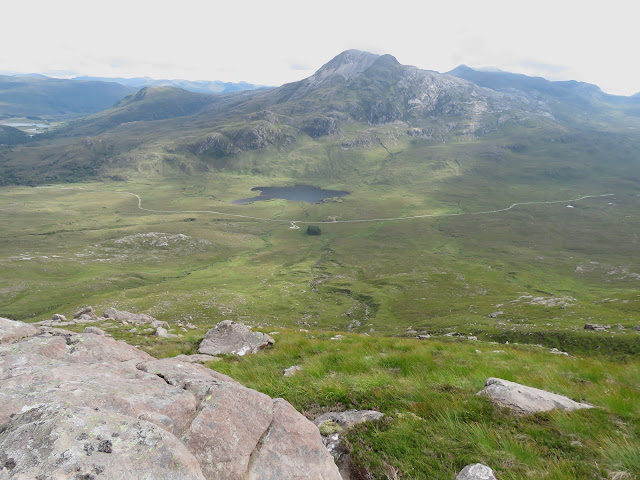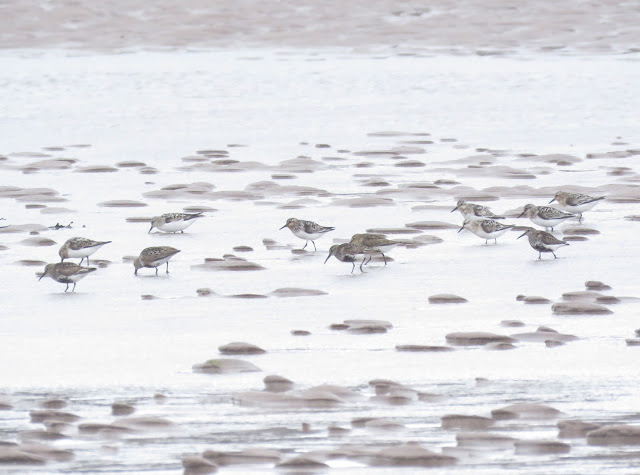Friday, August 19, 2022
The wind was against us as we walked up the beach at Achnahaird, and it was difficult to hold bins still, let alone a camera. I thought all the distant white blobs in the thrift were gulls until one turned to face us, and showed itself to be a grey plover.
Half a dozen sanderling and two curlews were also present. Across the headland, a flock of at least 20 dunlin landed at the water's edge and went to sleep, while a handful of adult gannets fished in the bay. Back at the junction lay-by on our way out, we heard the calls of redshanks - and a flock of twenty or so flew in, with a black-tailed godwit among them.
There might well have been other goodies around, but we were too tired to explore further and reluctantly headed for home.
Wednesday, August 17, 2022
We began our latest pelagic in warm sunshine - but out beyond the Summer Isles a cool breeze sprang up, leading to a partial desertion of the upper decks. On the outward trip we saw a few dolphins and porpoises, and I spotted a probable sooty shearwater while Greger was below buying a coffee.
Half an hour later there was more dolphin activity - and then something broke the surface that we both felt at the time was a minke whale. I could only grab one picture, in which the dorsal fin seems wrong in both shape and position on the whale's back. I'm not convinced, but after all it's a poor photo and Greger's happy that we saw a minke whale.
At Stornoway I scanned the harbour area but could see no common terns. Back on the boat it was now quite cold, but Greger went down and bought us both ice-creams - Magnum for him, strawberry Cornetto for me. And very nice they were too!
Somewhere in the Minch, leaning over the side on the upper deck, I spotted four or five tiny birds ahead. Clearly petrels going by their size, they remain unidentified, although I suppose they're most likely to be storm petrels. I clicked away blindly in their general direction, but failed to get anything but a rubbish record shot; still, at least I got the camera onto them this time.
Distracted by trying to relocate them, I probably missed a few shearwaters; but we did manage to identify one Manx.
A notable feature today was the number of large gatherings of kittiwakes on the sea, including juveniles; gannets, fulmars, and great skuas were also seen. All too soon we were gliding back up Loch Broom, and as we approached the quayside three terns were spotted on a buoy close to West Shore.
The two that are in full view are juveniles, while the partly hidden one looks as though it's more likely to be an adult; and having consulted my bird books: The short but not stubbily-short legs, the amount of both black and white around the eye, and the strong dark mark on the wing (secondary coverts apparently) all point to these being common terns. The sighting was a nice surprise at the end of the trip, and compensation for not seeing any terns in Stornoway.
Friday, August 12, 2022
Spidean Coire nan Clach (Beinn Eighe)
Making our way up steep slopes from Glen Torridon it sometimes seemed, from the crumbling sandstone and the sliding fans of scree, that the mountain itself was trying to make its way down!
The forecast had suggested that the weather would gradually clear, but we reached the triangulation pillar without having had more than tantalising glimpses of the views.
The trig point is a crooked affair made of stones; I couldn't see a flush bracket, but learnt from trig pointing.uk that the number is S9418. This however is not the summit.
That was just visible through the clouds; it lies a little to the north-east and is reached by an enjoyable scramble, so we left our rucksacks in the shelter and set off along the ridge.
The clouds parted momentarily to give us a view of the corrie and our route of ascent.
We made our way back to the trig point and began our descent, stopping for lunch by a cairn on the col that marks the start of the path down. A raven landed a little way off and was soon joined by a second bird, after which the cloud drifted across once more and blotted them out.
Below the cairn is the steepest section of the walk, involving first mud and grass, and then dry scree which rolls away under your feet taking you with it. It had been tiring to walk up but it was tiring in a different way to get down. We were relieved to get to the end of that stretch, and I even relaxed enough to spot a little bunch of starry saxifrage by a stream - a wildflower I've only once seen before (on the summit of Sgorr Ruadh, June 2018).
We found a handy seat and had a coffee stop, looking south-east over Loch Clair and Loch Coulin.
It was a bit annoying to note that the cloud really had cleared now, so anyone on the tops would be getting great views. We'd met two men making their way up separately. The first had nothing with him at all - no rucksack, not even a bottle of water; and the second one was carrying a mountain bike on his back. They both seemed quite cheerful! Looking back up the hill with bins, I realised that a triangular reddish scar was in fact a large hole. The path had passed close to it but we hadn't seen it.
I diverted out onto a small prominence to get a picture of the rest of the way down, with Loch Bharranch across the road from the car park and the Corbett Sgurr Dubh rising beyond.
On another hill-walk a few years back (the Beinn Liath Mhor ridge, July 2017), I took a picture of this mountain massif and remarked in the blog-post that we'd never ventured onto it. Well, now we have - and while it's a pity that we couldn't go on from the top to bag the other Munro on Beinn Eighe I have to accept our limitations these days and just be pleased we've been on it at all. (Munro number 148 for me, 108 for Greger.)
Tuesday, August 02, 2022
An incredibly strong wind and a shower of rain took some of the enjoyment out of a walk at Achnahaird today. In fact, I was surprised to see so many people on the beach. A mixed flock of a couple of hundred waders contained a few ringed plovers and at least 25 sanderling, with dunlin making up the numbers.
The waders flew several times, zooming round low and often landing closer to me than when they took to the air. A knot was less forgiving; but this was an adult bird, and perhaps they're more wary than juveniles. It was last seen heading up the beach so I hope it went down on the salt-marsh or river.
Across the headland, a bundle of white feathers floating on the rough sea near the shore could only be a gannet. I assumed it was dead, but the head suddenly came up and after a while the bird flapped its wings, took off, flew low over the water for a short distance - and went down again. It repeated this twice. Maybe the winds had defeated it for a while - or maybe it was a victim of avian flu. Two Bonxies were seen flying around, seemingly healthy - so far.


.jpeg)






















